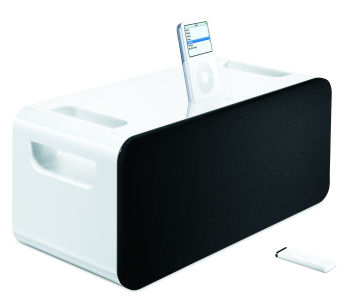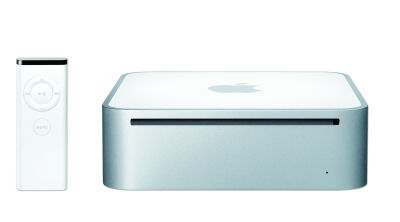Low-priced Core Duo-based Mac mini flanked by iPod's new portable speaker
UPDATE 5:40 pm ET 28 February 2006
Cupertino (CA) - Leave it to Apple CEO Steve Jobs to be capable of stopping the world for a half-hour, and have millions of fans worldwide chomp at the bit over news of a speaker system that runs on D-cell batteries.
Today's news of two new Mac mini computers - as expected, one based on Intel's Core Solo processor, the other on Core Duo - was merely the opening act for the premiere of iPod Hi-Fi. Complete with three speakers sealed in a plastic resin case, integrated power supply, and a hyphen (a first for Apple products), the device looks, at first glance, like a portable microwave oven with a speaker jammed into the door, and a recipe card slot on top. But that recipe card is a docked iPod, while the handles for the portable speaker reside in the corners, meaning it's designed to be carried with two hands without the iPod falling out of the dock.
Apple's new consumer appliance, the iPod Hi-Fi speaker add-on for iPod. (Courtesy Apple)
The new speaker unit sells for $349 - a price that lends its catch phrase, "Home Audio. Reinvented," a distinctively high-class meaning. While a simple universal power cord connects the new Hi-Fi to a wall outlet, it's also designed to run on six D-cell batteries, each of which probably weighs more than the iPod itself. A pack of six can probably be purchased through discount outlets for about $6.50.
Meanwhile, in computer news, the consumer electronics company has managed to introduce what is believed to be the least expensive Intel Core Duo-based computer platform currently available, at $799. The 1.66 GHz unit will include 512 MB of 667 MHz DDR2 memory, 64 MB of which is to be shared with the on-board Intel GMA950 graphics processor. Immediately, we noticed the lack of an ATI-brand GPU, since a Radeon X1600 is featured with the new Core Duo-based iMacs.
Apple's new Core Duo- or Core Solo-based Mac mini, pictured here with the Apple Remote. (Courtesy Apple)
Get Tom's Hardware's best news and in-depth reviews, straight to your inbox.
Had it not been for Dell's announcement just hours earlier of a $779 Core Duo-based Inspiron notebook, Apple's Mac mini would possibly have been the least expensive Core Duo-based PC system to date. At any rate, even without a monitor and other external gadgets - except for an AirPort WiFi USB dongle and an Apple Remote - the 1.66 GHz model does become one of the least expensive options available for dual-core performance.
The 1.5 GHz Core Solo-based system, at $599, may face a more difficult road ahead. While it's one of the first systems to sport Intel's new Core Solo designation, its single-core performance will continue to be compared against Pentium and Athlon systems. In that scenario, the raw gigahertz speed numbers might not help, nor will the 60 Gb 5400 rpm Serial-ATA hard drive, whose street prices in the "Wintel" PC realm currently average under $50. Even the Core Duo model features an 80 Gb 5400 rpm drive, whose average replacement cost runs under $60, although Ultra-ATA 133 drives with over three times the capacity currently sell for under $100. With all the performance features Apple is touting with their new systems, including Bluetooth connectivity and DVD+/-RW SuperDrive, one wonders why Apple is settling for bargain-basement hard drive performance...unless the company thinks its customers will be buying new drives along with new monitors anyway. Even if the new HDD units have a 2.5" form factor rather than the standard 3.5", as some of our readers commented today, size often doesn't matter that much, especially to veterans of Intel-based equipment.
Another curiosity is the DVI external display connection port. Although a converter is included for VGA, this could end up being a problem for customers planning to make a Mac mini the hub of their home media center PCs. Most next-generation high-definition TV components, it currently appears, will include HDMI connectors, which provide exactly the same video feed as DVI, although they also carry the audio feed and, in the long tradition of consumer electronics, are differently shaped. Consumers with the latest equipment, and who plan to use the Mac mini with Front Row media software and Apple Remote as their controllers, will need an adapter to connect the Mac mini to the latest HDTVs. The adapter itself isn't the problem; getting the audio feed adapted to work with the HDTV, might become one. The Mac mini does include an optical digital audio connector port; so whatever adapter the consumer uses may have to accept DVI and the Mac mini's flavor of optical audio on one side, and the HDTV's own flavor of HDMI on the other, with the result looking more like a 1980s model Atari home game console than a modern home media center.
In perfect Apple fashion, the new Mac minis became available via the online Apple Store the moment they were announced, along with the iPod Hi-Fi (which looks like it can also heat soup), and not to be outdone, a black leather case for new iPods and iPod nanos, which will sell for $99 each. At that price, perhaps the leather case should come with a free 60 Gb 5400 rpm hard drive.
UPDATE: TG Daily contacted Rahul Sood, the president and CTO of Voodoo PC, the manufacturer of the made-to-order Idol systems designed to run Windows, but whose architecture was clearly inspired by the Mac mini. Late this afternoon, Sood wrote, "I believe Intel will drive Apple to 8% market share in no time, and I also think the Mac mini is Apple's 'iPod of the living room.' It'll morph into some sort of computer disguised as an entertainment device. Of course, even though Microsoft has been driving the media center market for years, once Apple does it, everyone will perceive Steve Jobs as the Godfather of living room entertainment."
Perhaps alluding to Apple's popularization of, essentially, a big speaker, Sood added about Jobs, "That guy could take almost any existing technology and turn it into a mainstream phenomenon. It's almost unbelievable, because [Apple's] innovations are evolutionary but are perceived as revolutionary."

